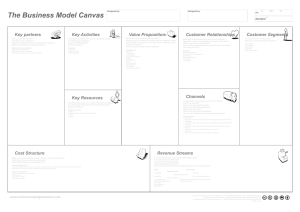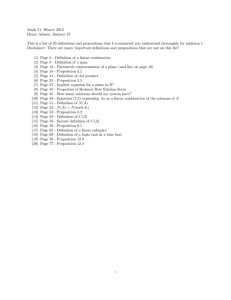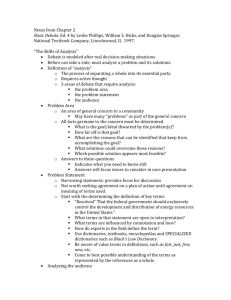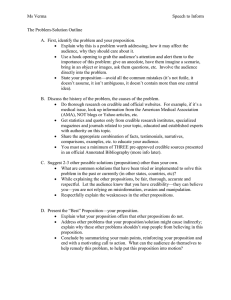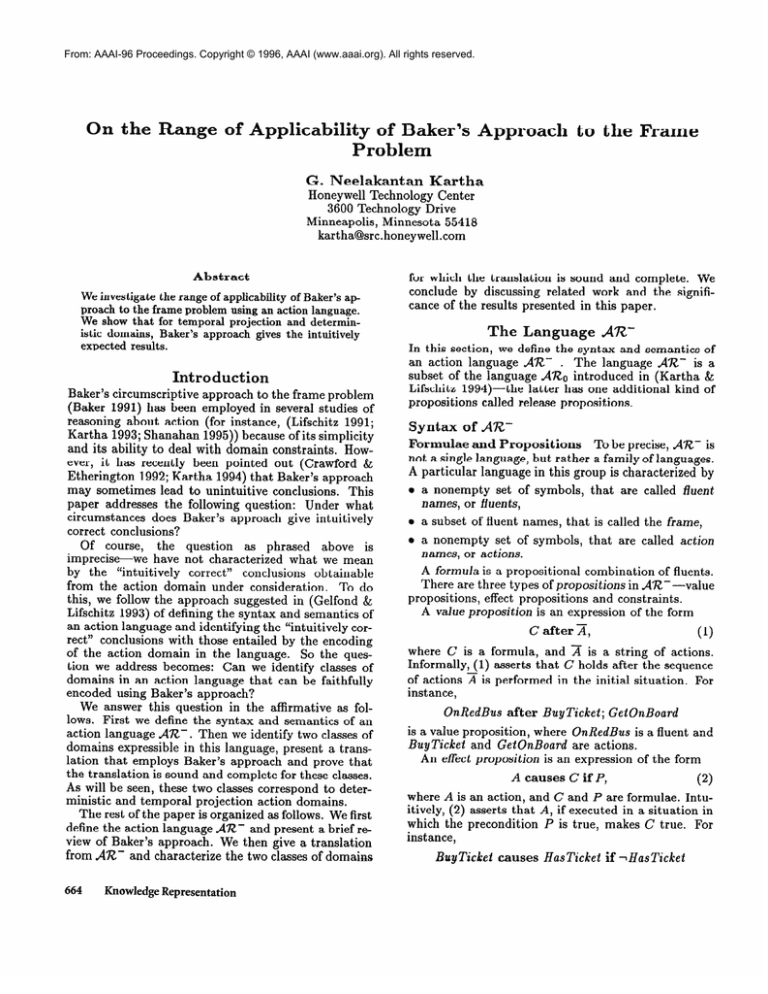
From: AAAI-96 Proceedings. Copyright © 1996, AAAI (www.aaai.org). All rights reserved.
On the Range of Applicability of Baker’s Approach to the Frame
Problem
G. Neelakantan
Kartha
Honeywell Technology Center
3600 Technology Drive
Minneapolis, Minnesota 55418
kartha@src.honeywell.com
Abstract
We investigate the range of applicability
of Baker’s approach to the frame problem using an action language.
We show that for temporal
projection
and deterministic domains,
Baker’s approach
gives the intuitively
expected results.
Introduction
Baker’s circumscriptive approach to the frame problem
(Baker 1991) h as b een employed in several studies of
reasoning about action (for instance, (Lifschitz 1991;
Kartha 1993; Shanahan 1995)) because of its simplicity
and its ability to deal with domain constraints. However, it has recently been pointed out (Crawford &
Etherington 1992; Kartha 1994) that Baker’s approach
may sometimes lead to unintuitive conclusions. This
paper addresses the following question: Under what
circumstances does Baker’s approach give intuitively
correct conclusions?
Of course, the question as phrased above is
imprecise- we have not characterized what we mean
by the “intuitively correct” conclusions obtainable
from the action domain under consideration.
To do
this, we follow the approach suggested in (Gelfond &
Lifschitz 1993) of defining the syntax and semantics of
an action language and identifying the “intuitively correct” conclusions with those entailed by the encoding
of the action domain in the language. So the question we address becomes: Can we identify classes of
domains in an action language that can be faithfully
encoded using Baker’s approach?
We answer this question in the affirmative as follows. First we define the syntax and semantics of an
action language AR-.
Then we identify two classes of
domains expressible in this language, present a translation that employs Baker’s approach and prove that
the translation is sound and complete for these classes.
As will be seen, these two classes correspond to deterministic and temporal projection action domains.
The rest of the paper is organized as follows. We first
define the action language dR- and present a brief review of Baker’s approach. We then give a translation
from AR- and characterize the two classes of domains
664
Knowledge Representation
for which the translation is sound and complete. We
conclude by discussing related work and the significance of the results presented in this paper.
The Language
AR-
In this section, we define the syntax and semantics of
an action language AR. The language AR- is a
subset of the language d7& introduced in (Kartha &
Lifschitz 1994)-the
latter has one additional kind of
propositions called release propositions.
Syntax of ARTo be precise, AR- is
Formulae and Propositions
not a single language, but rather a family of languages.
A particular language in this group is characterized by
e a nonempty set of symbols,
names, or Auents,
that are called Auent
m a subset of fluent names, that is called the frame,
o a nonempty set of symbols,
names, or actions.
that are called action
A formula is a propositional combination of fluents.
There are three types of propositions in AR--value
propositions, effect propositions and constraints.
A value proposition is an expression of the form
C after A,
0)
where C is a formula, and ‘7? is a string of actions.
Informally, (1) asserts that C holds after the sequence
of actions x is performed in the initial situation. For
instance,
OnRedBus
after BuyTicket;
GetOnBoard
is a value proposition, where OnRedBus is a fluent and
BuyTicket
and GetOnBoard are actions.
An effect proposition is an expression of the form
A causes C if P,
(2)
where A is an action, and C and P are formulae. Intuitively, (2) asserts that A, if executed in a situation in
which the precondition P is true, makes C true. For
instance,
BuyTicket
causes
HasTicket
if -HasTicket
is an effect proposition, where BuyTicket is an action,
and HasTicket is a fluent.
Finally, a constraint is a proposition of the form
always C,
(3)
where C is a formula. Intuitively, (3) asserts that C
holds in all possible situations. For instance,
always
OnRedBus
3 HasTicket
is a constraint. We will sometimes identify a constraint
(3) with the formula C.
A domain description, or domain, is a set of propositions.
Notational
Conventions
In formulae, we will omit
some parentheses, as customary in classical logic. If 71
in a value proposition (1) is empty, we will write this
proposition as
initially
C.
Otherwise, the members of 2 will be separated by
semicolons. An effect proposition (2) will be written
as
A causes C
if P is True.
Examples
In this section, we give two examples to illustrate how
we can describe action domains in AR-.
1. We will first show how to formalize an
extension of the “Yale Shooting” domain (Hanks &
McDermott 1987) in dR-, since this example is likely
to be familiar to the reader. The formalization is as
follows.
Example
always Walking > Alive,
initially 1 Loaded,
initially Alive,
Load causes Loaded,
Shoot causes -Alive if Loaded,
Shoot causes 1 Loaded.
(4)
All fluents belong to the frame. Once the semantics
of AR- is given in the next section, we will be able
show, for instance that the domain description (4) entails, for instance, the value proposition
1 Walking after Load; Wait; Shoot.
Note that the fluent Walking does not occur in the
effect propositions. Thus any change in the value of
Walking is an indirect effect, or ramification, of the
actions that have been performed.
2. We will now formalize the “Two Bus”
example from (Kartha 1994). The task here is two
formalize the actions of a commuter who has to take
a bus to work. There are two buses that take him to
work, one red and the other yellow, and the commuter
catches the first bus that comes by. The commuter can
Example
board a bus only if he has a ticket. On a particular day,
he does not have a ticket initially, and after purchasing
the ticket and getting on board, he is on the red bus.
This domain can be formalized as follows.
always OnRedBus
> HasTicket,
always On YellowBus
> HasTicket,
always -(On YellowBus A OnRedBus),
initially -HasTicket,
GetOnBoard,
OnRedBus after BuyTicket;
Buy Ticket causes HasTicket if THusTicket,
GetOnBoard
causes OnRedBus
v OnYellowBus
HasTicket A -0nRedBus
A -0nYellowBus.
if
(5)
Again, all fluents belong to the frame. Note that in
this domain, the action GetOnBoard is nondeterministic.
Semantics
of AR-
States ad
Transition Functions
In this section,
we consider truth-valued functions on the set of fluents
Such a function can be extended
called valuations.
to arbitrary formulae according to the truth tables of
propositional logic.
We say that a valuation o is a state of a domain D
if it maps every constraint in D to T (“true”).
For instance, the domain (4) has 6 states; they are
the truth-valued functions on
(Loaded,
Alive, Walking)
that make the formula Walking > Alive true.
The semantics of AR- shows how the effect propositions of D define a nondeterministic transition system with this set of states, whose input symbols are
actions. We will describe this transition system by a
function Res that maps an action and a state to a set
of states. The elements of Res(A, a) are, intuitively,
the states that differ from 0 as dictated by the effect
propositions for A, but, at the same time, differ from
CTas little as possible. In determining the “difference”
between u and the elements of Res(A, a), we will consider only the frame fluents.
As a preliminary step, define Reso(A, 0) to be the
set of states 6’ such that, for each effect proposition
A causes C if P in D, a’(C) = T whenever b(P) =
T. The set Res(A, a) will be defined as the subset of
Reso(A, a) whose elements are “close” to (T.
In order to make this precise, the following notation
is needed. The distance ~(01, ~2) between states 01
and 02 is the set of fluents on which the states differ:
p(wfl2)
=
{F
I m(F)
#
a2(F)).
Let fi denote the frame.
Now the transition function Res corresponding to D
is defined as follows: Res(A, a) is the set of states CT’
E
Reso(A, a) for which p(u, a’) n Fr is minimal relative
to set inclusion- in other words, for which there is no
u” E Reso(A, u) such that p(u, a”) fl Fr is a proper
subset of p(u, a’) n F’r.
Reasoning about Action
665
Consider, for instance, the domain (4).
We will
represent a state LTby the set of fluents F such that
a(F) = T. In this notation,
Reso( Load, {Alive})
=
Res( Load, {Alive})
=
{{Loaded),
{Loaded,
{(Loaded,
{Loaded, Alive),
Alive, Walking}},
Alive}};
A structure is a partial
function from strings of actions to valuations whose
domain is nonempty and prefix-closed. If a structure \E
is defined on a string A, we say that 2 is executable in
\E. Thus, note that in any structure, the empty string
of actions is always executable. As we will see shortly,
%P(x) in a model of D represents the state that results
from the execution of the members of 3 sequentially
from the initial state.
A value proposition (1) is true in a structure \E if
‘7i is executable in \E and Q(x)(C)
= T. A constraint
always C is true in_a structure \E if for any string Z
executable in \E, XI!(A)(C) = T.
A structure 9 is a model of a domain D if every
value proposition and every constraint in D is true in
9, and, for every string of actions x executable in Q
and every action A,
Models
l
and
the situation constant So. For this to work correctly,
Baker needs an existence of situations axiom, which
says that corresponding to each set of Auents consistent with the domain constraints, there is a situation
in which exactly these fluents hold. To this end, he
introduces the following axiom:
lAbSit
Entailment
if XA is executable
in Q, then
@@A)
o otherwise, Res(A,
E Res(A,
Q(x))
q(x)),
= 0.
We say that a domain description is consistent if it
has a model. Two domain descriptions are equivalent
if they have the same models. A value proposition is
entailed by a domain description D if it is true in every
model of D.
For instance, it is easy to see that the domain (4)
has two models that that differ by the initial value
of WaZking. As remarked before, it entails the value
proposition
1 Walking after Load; Wait; Shoot.
A Brief Review
of Baker’s
Approach
As is standard with circumscriptive approaches to reasoning about action, Baker [1991] starts with a theory
that includes axioms encoding the effects of actions,
domain constraints and the commonsense law of inertia:
lAb( f, a, s) > [HoZds( f, s) E HoZds( f, ResuZt(a,
s))].
Here, Ab(f, a, s) is an “abnormality” predicate (McCarthy 1986) which stands for the fluent f being abnormal with respect to action a in situation s. The key
innovation that Baker proposes is to change the way
circumscription is applied to this theory-instead
of
circumscribing Ab while varying the predicate Holds
as is done in (Hanks & McDermott 1987), Baker circumscribes Ab while varying the function Result and
Knowledge Representation
2 Vf[HoZds(f,
Sit(X))
3 X(f)].
Here X is a unary predicate variable, Sit a function
from unary predicate variables to situations and Absit
an abnormality predicate on fluent predicates.
The
idea is that by circumscribing Absit, we would get that
X is in the extent of Absit iff the set of all fluents f such
that A(f) h o Ids violates some constraint. That is, for
each subset 2” of the set of fluents consistent with the
set of constraints, there is a situation where precisely
those fluents in T hold. The following unique name
axiom for Sit is necessary to make this work correctly:
Sit(X1)
= Sit&)
> A1 = x2.
Translating from MC- into a
Circumscriptive
Theory
In this section, we present a translation from a subset
We restrict attention to finite domains, that
of AR-.
is, to domains with finitely many fluents, actions and
propositions.
We impose one additional restriction to the domains
to be translated. We define a domain description D to
be executable ’ if, for every action name A and every
state 0 of D, Res(A, a) # 8. We restrict attention to
executable domain descriptions.
We will transform a finite, executable domain D in
the sense of the language AR- into a circumscriptive
theory whose language L has variables of three sorts:
for fluents, actions and situations. These variables will
be denoted respectively by f, fi, f2, . . .; a, al, ~2,.. .;
In addition, L has predicate variables
S,Sl,S2 ,...*
that range over properties of fluents.
~,~1,~2,...
The language has the following object constants:
l
the fluents of D,
e the actions of D,
o the situation constant So.
The language L contains the following function and
predicate constants:
o the unary predicate FrameFluent,
is a fluent,
e the binary predicate Holds,
are a fluent and a situation.
l
whose argument
whose two arguments
function Result , which takes an action
and a situation and gives a situation.
the binary
‘Similar concepts,
for other action languages,
were introduced
in (Dung 1993) (“selfcontradicted
actions”)
and
in (Denecker & De Schreye 1993) (“e-consistency”).
the ternary predicate Ab, whose arguments
fluent, action and a situation
are a
the unary predicate AbSit , whose argument
unary predicate on fluents.
is a
the unary function Sit, which takes unary predicate
on fluents as its argument and returns a situation.
Note that “formulae” as defined in the earlier section
on the syntax of AR- are not among the formulae of
L. To avoid confusion, we will refer to the former as
For any domain formula C,
as “domain formulae.”
by T(C, s) we will denote the formula of L obtained
from C as the result of replacing each fluent name F
by HoZds(F, s). For instance, T(lAlive
A Loaded, s)
stands for
yHolds(Alive,
s) A Holds(Loaded,
For any string of actions Al..
we will denote the ground term
Result(A,,,,
ResuZt(A,-1,.
Law of Inertia
s).
as
Holds( Loaded, s) > yHolds(Alive,
Finally, if P is a constraint
s). For instance,
. . , ResuZt(A1,
So), . . .)).
of Situations
Our translation p from AR- uses two defaults. The
first one is the commonsense law of inertia, which we
restrict to the frame fluents (following (Lifschitz 1991))
as follows:
always
A TAb(f,a,s)
>
ResuZt(a, s)) E HoZds(f,
> Vf(HoZds(f,
Sit(X))
E
is translated
as
Holds(
Definition
Walking, s) 1 Holds(Alive,
By F we will denote the set of fluents in the language
of D, by fi the set of frame fluents, by A the set of
actions. The axioms of the auxiliary translation /?D
will now be given.
Group 2. Unique names axioms:
FI #
Al #
Sit&)
Group
= Sit(&)
m).
= F,
Result(Shoot,
SO)).
If P is an effect proposition A causes C if P, then
PP is
T(P, s) > T(C, Result(A, s)).
For instance, the proposition
Shoot causes -Alive
v
&A
Group
3. Translations
Oi= A.
of the propositions:
PP
(P E D).
4. Characterization
of FrameFluent:
Group
P-4
5. The Two Defaults
LI
ES.
By B(D), we will denote the circumscriptive theory
whose axioms are p(D) and whose policy declarations
(Lifschitz 1993) are the following:
circ FrameFluent
var Ab,
circ A bSit var Ab, Holds, Result, So,
circ A b var Result, So.
after Shoot
as
lHolds(Alive,
3 A1 = x2.
2. Domain closure axioms:
FrameFZuent(F)
For instance, the proposition
is translated
A2
for all pairs of distinct actions Al, A2 E A, and
Group
We first define an auxiliary translation /3D of the domain D. We will define how to construct, for each
proposition P in D, the corresponding formula PP.
These formulae will be included in theJranslation
,f3D.
If P is a value proposition C after A, then /?P is
1Alive
F2
for all pairs of distinct fluents Fl, F2 E F,
X(f))].
Propositions
w>
s).
of B(D)
s)].
This formula will be denoted by ES.
Translating
C, then /3P is
FEF
This formula will be denoted by LI.
The second default, the existence of situations principle, is expressed by the formula
lAbSit
always
s)).
Walking > Alive
Vf
FrameFluent
[HoZds(f,
Result(Shoot,
T(C,
by [Al . . .A,,J
.A,,
and Existence
is translated
if Loaded
The following facts have been established regarding
the soundness and completeness of B.
Let D be a finite, executable domain, let Q be a
model of D, and let M be a model of B(D).
We say
that A4 is similar to \E if, for e_very domain formula
C and every string of actions A, the value proposition C after X is true in \E if and only if M satisfies
T(C, PI).
Reasoning about Action
667
Theorem
1. Let D be a finite, executable
domain.
For any model 9 of D, there exists a model M of B(D)
similar to \E.
The following corollary expresses the soundness of
the translation.
Corollary.
Let D be a finite, executable domain. For
any domain formula C and every string of actions 2,
if the formula T(C, [Z]) is entailed by B(D) then the
value proposition C after 2 is entailed by 13.
There are two important cases when the translation
is complete.
A doOne is the case of “temporal projection.”
main D is a temporal projection domain if every value
proposition in D is of the form initially C. For instance, the action domain (4) is a temporal projection
domain. Obviously, the domains that contain no value
propositions are temporal projection domains.
2. Let D be a finite, consistent, executable,
temporal projection domain.
For any model M of
B(D),
there exists a model q of D such that M is
Theorem
similar
to Q.
The following corollary expresses the completeness
of the translation for temporal projection domains.
Let D be a finite, consistent, executable,
temporal projection domain.For
any domain formula
C and every string of actions A, if the value proposition
C after 2 is entailed by D then the formulaT(C,
[a)
is entailed by B(D).
Corollary.
The second case is the case of “deterministic” domains. A domain D is deterministic if, for every action A and every state CT,Res(A, a) is a singleton. For
instance, the domain (4) is deterministic.
Obviously,
every deterministic domain is executable.
Theorem 3. Let D be a finite, consistent, deterministic domain. For any model M of B(D),
there exists
a model Q of D such that M is similar to Q.
Corollary.
Let D be a finite, consistent, deterministic
domain.
FE any domain formula C and every string
of actions A, if the value proposition
C after A is
yyta.$exf, by D then the formula T(C, [A]) is entailed
.
Discussion
Two papers that are closely related to the work presented in this paper are (Lifschitz 1991; Kartha 1993).
In (Lifschitz 1991), Baker’s method is applied to a class
of problems characterized in terms of their syntactic
form. In (Kartha 1993), a soundness and completeness
result is presented for a translation from an action language A. The results presented in this paper can be
seen as extensions of the work presented in these two
papers. For instance, the soundness and completeness
668
KnowledgeRepresentation
result from (Kartha 1993) is subsumed by Theorems 1
and 3, because A domains can be thought of as a special case of deterministic AR- domains where there
are no constraints.
Note that we have restricted attention here to executable domains. To adequately deal with domains
that are not executable, the symbol Result in the situation calculus should be viewed as representing a partial function. This can be technically achieved, for example, using the “possibility” predicate, as in (Reiter
1991). Baker El9911 t reats Result as total, and we chose
not to modify his approach in this respect.
Roughly, why Baker’s approach works on temporal
projection domains and deterministic domains can be
explained as follows. First of all, it is important to
note a crucial difference in the role that value propositions play in AR- and in the circumscriptive theory
B(D).
In the definition of the semantics of AR-, value
propositions play no role in determining the transition
function Res-they
are used only in “filtering” structures to determine whether they are models (Sandewall
1989). However, the set of axioms that are circumscribed to obtain the theory B(D) include the translations of the value propositions and hence they play a
role in determining the Result function.
Due to this difference in the role that value propositions play in determining the effects of actions in
AR- and in B(D), a correspondence between these
action representations is possible only when the value
propositions are suitably restricted. In the case of temporal projection domains, the value propositions are
restricted to the initial situation.
In the case of deterministic domains, they are again restricted due to
the requirement that they be consistent with values allowed by the deterministic transition function Res. In
either case, the restrictions suffice to guarantee that
the translations of the value propositions do not not
interfere with the circumscriptions in B(D) in unforeseen ways.
Consider now the “Two Bus” domain (5). It is easy
to show that this domain entails
HasTicket
A -0nRedBus
A -On YellowBus
after BuyTicket.
Wowever, it can be shown (Kartha 1994) that for this
domain, Baker’s circumscription does not entail the
corresponding formula
Holds( HasTicket, Result( Buy Ticket, ,!!&))A
-Holds( OnRedBus, Result(BuyTicket,
$))A
-Holds( OnYellowBus,
Result( BuyTicket, So)).
Note that (5) is neither a deterministic nor a temporal
projection domain. This observation, in conjunction
with the soundness and completeness results for temporal projection and deterministic domains gives us a
sharp characterization of the class of action domains
where Baker’s method is applicable.
Acknowledgement:
I am grateful to Vladimir Lifschitz for discussions related to the topic of this paper.
the First Int ‘1 Conf on Principles of Knowledge
resentation and Reasoning, 412-420.
Shanahan,
Draft.
References
M.
1995.
Solving
the Frame
Rep-
Problem.
Baker, A. 1991.
Nonmonotonic reasoning in the
framework of situation calculus. Artificial Intelligence
49:5-23.
Crawford, J., and Etherington, D. 1992.
ing reasoning about change: A qualitative
approach. In Proc. AAAI-92, 577-583.
Formalizreasoning
Denecker, M., and De Schreye, D. 1993. Representing incomplete knowledge in abductive logic programProceedming. In Miller, D., ed., Logic Programming:
ings of the 1993 Int ‘I Symposium,
147-163.
Dung, P. M. 1993. Representing actions in logic programming and its applications in database updates.
In Logic Programming:
Proceedings of the Tenth Int ‘1
Conf
on Logic Programming,
222-238.
Gelfond, M., and Lifschitz, V. 1993. Representing
action and change by logic programs. Journal of Logic
Programming
17~301-322.
Hanks, S., and McDermott, D. 1987. Nonmonotonic
logic and temporal projection. Artificial Intelligence
33(3):379-412.
Kartha, G. N., and Lifschitz, V. 1994. Actions with
indirect effects.
In Doyle, J.; Sandewall, E.; and
Torasso, P., eds., Proc. of the Fourth Int’l Conf. on
Principles of Knowledge
ing, 341-350.
Representation
and Reason-
Kartha, G. N. 1993. Soundness and completeness theorems for three formalizations of action. In Proc. of
IJCA I-93, 724-729.
Kartha, G. N. 1994. Two counterexamples related
to Baker’s approach to the frame problem. Artificial
Intelligence
69:379-391.
Lifschitz, V. 1991. Towards a metatheory of action. In
Allen, J.; Fikes, R.; and Sandewall, E., eds., Proc. of
the Second Int’l Conf. on Principles
of Knowledge
Representation
and Reasoning, 376-386.
Lifschitz, V. 1993. Circumscription.
In Gabbay, D.;
Hogger, C.; and Robinson, J., eds., The Handbook of
Logic in AI and Logic Programming,
volume 3. Oxford University Press. 297-352.
McCarthy, J. 1986. Applications of circumscription
to formalizing common sense knowledge. Artificial
Intelligence 28(1):89-116.
Reiter, R. 1991. The frame problem in the situation
calculus: A simple solution (sometimes) and a completeness result for goal regression. In Lifschitz, V.,
ed., Artificial Intelligence and Mathematical
Theory
of Computation.
Academic Press. 359-380.
Sandewall, E. 1989. Combining logic and differential
equations for describing real-world systems. In Brachman, R.; Levesque, H.; and Reiter, R., eds., Proc. of
Reasoning about Action
669




